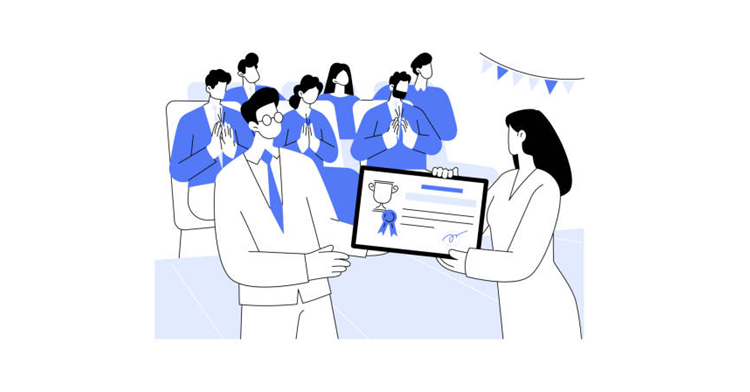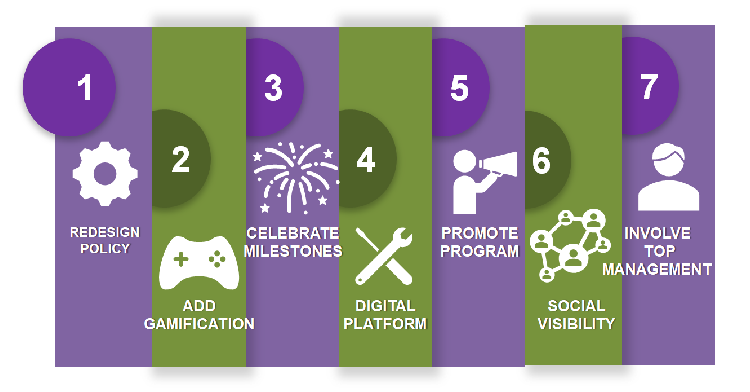1. Revive a dying employee recognition program by redesigning the recognition policy to align with current employee expectations and business needs.
2. Incorporate gamification elements, such as reward points and leaderboards, to enhance the program’s engagement and motivation.
3. Celebrate key employee milestones and ensure the recognition platform is modern and seamless.
4. Enhance program visibility through effective communication, social media integration, and active involvement from top management to increase credibility and participation.
Employee recognition programs that have not kept pace with the needs and expectations of employees are fast becoming irrelevant and ineffective for their organizations. However, there are ways an organization can revive a dying employee recognition program.

Today, employees prefer to work for organizations where they can effectively utilize their skills, feel engaged and appreciated, and see opportunities for career growth.
Hence, it is a must for organizations to have well-designed and effective employee recognition programs in place for their workforce.
Recognizing employees for their efforts and achievements has a significant impact on business growth and success. Numerous studies have shown this:

94% of HR professionals believe that an effective rewards and recognition program helps drive business results besides enhancing employee retention, according to an HR study,

Having well-designed rewards and recognition programs helps to enhance average employee performance and efficiency by around 11%, according to research from Gunther

69% of employees are likely to work harder if their organization focuses on appreciating their efforts better and it also helps decrease the voluntary turnover rate by 31%, based on a report from Cicero.

Another study has revealed that nearly 47% of the employees surveyed stated that receiving personalized, performance-related, and spontaneous recognition helps them stay motivated.

A study from Gallup highlighted the fact that 83% of HR leaders believe that employee rewards and recognition programs go a long way in reinforcing organizational values and improving engagement.
Most organizations adopt a launch-and-forget approach toward their recognition programs.
Hence, they tend to ignore the various signs that might indicate that the recognition program is losing its effectiveness.
It may harm the organizations in the long run, as the programs significantly lose their impact over time.

Here are vital signs organizations should look for to assess if their recognition program is fading.
1. Steady Decline In Key Program Metrics
2. Poor Program Performance Against Industry Benchmarks
3. Growing Dissatisfaction About The Program
4. Gradual Decline In Employee Engagement Levels
It is time for them to start looking for ways to revive the dying program:


Employees who do not receive regular rewards for their efforts and contributions often feel dissatisfied and undervalued.
Hence, a consistent decline in the recognition program’s key metrics should begin to alarm the organization.
A steady drop in key metrics such as the number of employees recognized, percentage of employees being recognized, or number of managers recognizing their team members.
Or managers are repeatedly recognizing only specific employees.
One of the leading indicators of problems in the program is that employees receive recognition even when they do not meet the predefined criteria.

Additionally, organizations need to constantly analyze the performance of their recognition programs against industry benchmarking data.
The program’s underperformance on various critical metrics compared to its industry peers suggests that it may not be performing as well.
Hence, organizations need to act without further delay.

An increasing mismatch between what employees expect from the recognition program and what the program offers is detrimental.
It can lead to poor employee satisfaction levels and, eventually, poor participation rates.
Such dissatisfaction often comes out in employee pulse surveys, team meetings, exit interviews, etc.
It is crucial to heed such signs and take immediate action to revive the ailing program.

Although there are multiple reasons for a decline in employee engagement levels, a fading employee recognition program may be one of the fundamental causes.
Poor employee engagement might manifest itself in multiple ways.
Hence, a gradual dip in employee engagement might be a warning sign of a dying recognition program.
Low engagement may result in a lack of enthusiasm for new projects and initiatives, as well as discord with supervisors and coworkers.
They are reporting late to work, absenteeism, and increasing attrition rates.
Once an organization has observed the above signs that its employee recognition program is in decline, it must take corrective action to revive the program.
Here are seven effective hacks to bring a dying employee recognition program back to life:
1. Redesign The Recognition Policy
2. Add Gamification Elements
3. Celebrate Key Employee Milestones
4. Use An Effective Recognition Platform
5. Promote The Recognition Program
6. Create Social Visibility Of Recognition
7. Involve The Top Management


Organizations should establish a process for regularly updating recognition categories, criteria, and monetary rewards.
It helps keep the program in sync with the changing employee expectations, business needs, and industry trends.
Importantly, introducing new criteria and categories regularly ensures that every employee gets a fair chance of being recognized for their unique skills and contribution to the organization.
It helps increase the program’s relevance for the workforce and its impact on their motivation levels.

Increasingly, incorporating gamification elements in the recognition program can revive employees’ interest levels.
This can be achieved by introducing concepts such as reward points, a variety of redemption options, leaderboards, wall of fame, contests, and challenges to keep the recognition program exciting and engaging for the employees.
Gamification fosters a healthy competitive environment within the workplace, enhancing employee performance and productivity.
It also helps make the recognition program more closely aligned with business outcomes.

Recognizing employees and celebrating the key milestones such as birthdays, work anniversaries, weddings, and parenthood as a part of the recognition policy is another strategy that can help to revive a dying employee recognition program.
Such initiatives help assure the employees that the organization acknowledges the critical moments in their personal lives and is keen to share their happiness.
It helps strengthen the sense of belongingness among employees.

An organization that uses a manual process for employee recognition or even an outdated digital platform should consider replacing it with a modern system.
An effective employee recognition software comes with various advanced features. These include instant recognition, gamification, social media integration, and much more.
A good recognition platform can help incorporate various industry best practices into the program, aligning it with employees’ evolving recognition needs and expectations.
Such a platform can help the organization increase the program’s effectiveness in the short term and maintain it in the long run.

Regular communication and promotion of the employee recognition program at all levels and forums is critical to its success.
Organizations should also consider organizing employee appreciation days or weeks. Such events can create good visibility and excitement around the program and increase the participation of employees.
Moreover, organizations can align these employee appreciation events with relevant calendar events, such as World Thank You Day, Employee Appreciation Day, or International Day of Gratitude.
Supervisors should be encouraged to recognize their team members’ achievements, and coworkers should express gratitude toward one another.

Additionally, the social buzz around the employee recognition program can go a long way in reversing its decline.
Award ceremonies, integration with internal collaboration platforms, publishing recognition on the company’s social media handles, and other methods can help achieve the program’s social visibility.

One of the leading causes of poor employee recognition program performance is the lack of involvement from top management.
The active involvement of the top management lends significant credibility to the program and enhances its importance and interest in the eyes of the employees.
Top management should recognize and reward employees directly and congratulate award winners on digital platforms.
Additionally, they should actively participate in award ceremonies, online or offline.
It is well known that effective and timely employee recognition motivates the workforce and helps boost business growth and productivity. Hence, an organization needs to understand the warning signs and act quickly to revive a dying employee recognition program.

Lead author: Sagar Chaudhuri, the Co-Founder and CEO of HiFives. He is an HR Tech Evangelist with over 25 years of experience in both corporate and entrepreneurial settings. Previously, Sagar has held leadership roles with companies such as Genpact, Infosys, and ICICI Bank. He has an engineering degree from IIT Kharagpur and an MBA from IIM Lucknow. Connect on LinkedIn
To stay updated on the latest HiFives blogs, follow us on Twitter (@MyHiFives) and learn more about HR Best Practices on HiFives.